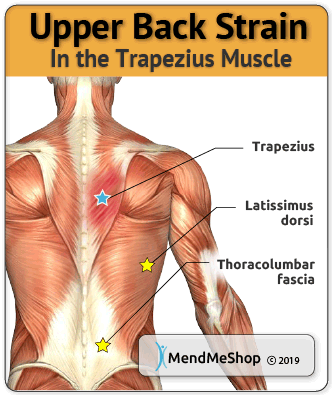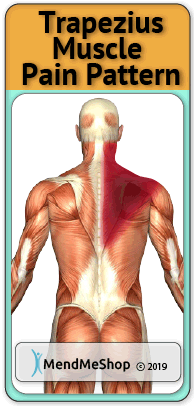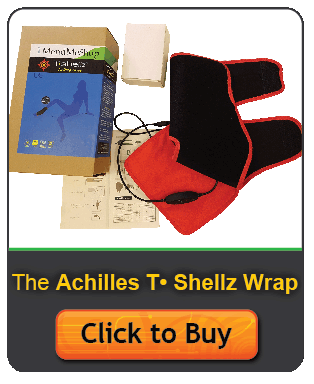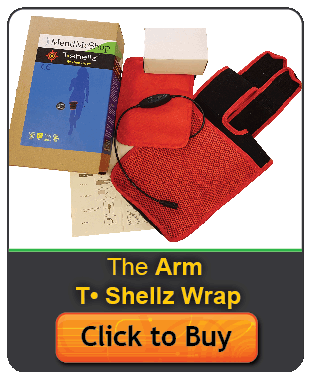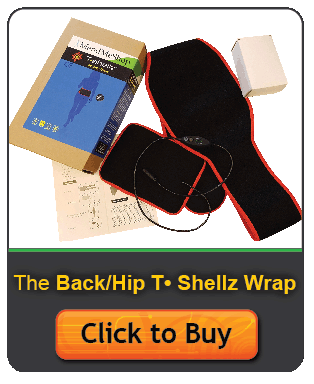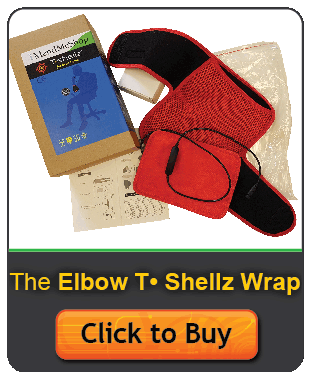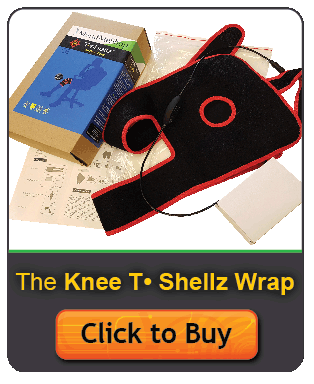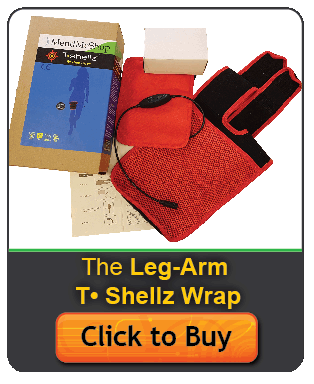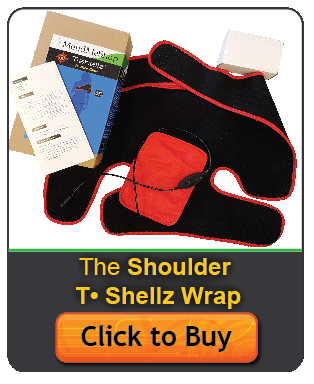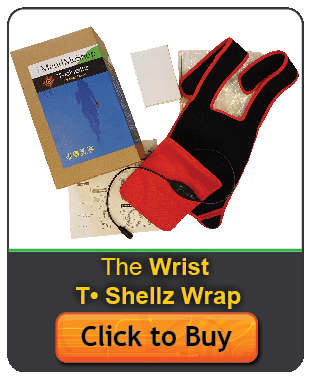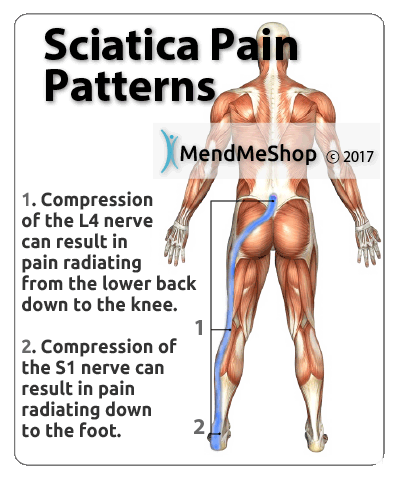Upper Back Strain (Trapezius Muscle Strain)
Related Term: Trapezius Myalgia
Trapezius myalgia is a medical term that means chronic (long term) pain of the trapezius muscle.
An Overview of Trapezius Muscle Strain
The trapezius muscle is one of the largest muscles in the body, extending down from the neck to the middle of the upper back and stretching across the shoulder blades.
The main job of the trapezius muscle is to stabilize and move the shoulder blades (scapula). We put our trapezius muscle into action with regular simple activities lifting, pulling or rotating the neck, moving your arms, throwing a ball, push our arms in an overhead press, shrug you shoulders and help us breath.
The trapezius is subdivided into three sections - the upper, middle and lower. The muscle starts off from the back of the head, and runs down the spine, and across to the shoulder region, (clavicle, acromion and scapula). The nerves controlling the trapezius are supplied by nerves in the upper spine and a cranial nerve called the "accessory" nerve. If there is some nerve damage or pinching in the upper neck, you may find the trapezius is one of the muscles that go into spasm. Learn more about muscle spasms here.
The shoulder and neck joints are some of the most frequently used parts of the body. When abused through either overuse, over-straining or chronic mispositioning - the impact may present itself in multiple ways.
Symptoms of Trapezius Strain
- You are getting frequent headaches - more-so than normal.
"Trapezius hypertonicity and spasm is a common cause of tension headaches among the general population. Due to the path of the accessory nerve and occipital nerve, they can become entrapped, causing the classic ram's horn distribution of a tension headache. This headache is bilateral, throbbing, traveling from the occipital region, and wrapping around to the top of the head and forehead region." (Ourieff, J. and Agarwal, A.
Ourieff, Jared, and Amit Agarwal. "Anatomy, Back, Trapezius." StatPearls Publishing (2018):. Web. 17 Feb. 2019.)
- You are experiencing neck pain. This can get VERY uncomfortable as the back of the neck is a very busy area in terms of nerves and soft tissue structures (muscles, tendons). Neck pain can be sharp or dull, and may expand into the base of the skull or radiate outward into the shoulder and even down the arm to the hand and fingers.
- You are experiencing tingling or numbness down the arm and possibly into the hand and fingers. Pressure on nerves can be caused by inflammation/swelling of the muscle - this pressure is often manifested through numbness and/or tingling (pins and needles).
- You are experiencing weakness in the shoulder. Weakness in tendons and muscles can develop as the pain worsens and inflammation in the area spreads.
- You have jaw pain.
- You are experiencing pain in the shoulder and arm.
- You have eye strain. Tension in muscles of the neck and upper back may restrict blood flow to the eyes, facilitating eye strain.
- You have a stiff neck.
If one or more of those statements are true, you might be suffering from a strained or spasming trapezius muscle in your upper back and shoulder. Some of these symptoms can be applicable to a multitude of injuries - some of them quite serious. This is why it is important to consult a physician for a proper diagnosis when such symptoms appear - you need to know what you are dealing with!
What Causes Upper Back Strain in the Trapezius?
Activities of daily life can easily result in overuse of your neck, upper back and shoulders. Chronic overuse or stress on these areas will lead to a strain or other form of injury. Common causes of strain on the upper back, shoulders and neck are:
- bending over a desk for long periods between breaks
According to Science Daily (Jan.2008): "Sitting at a desk and working on a computer for an extended period of time with protracted shoulders and/or viewing a monitor which is not at eye level height may cause stress and tension in the trapezius muscles, thus leading to headaches."
- emotional stress - this often can manifest in a tightening of muscles in the neck and shoulder blades (upper trapezius) areas
- overextending or over-working the upper back and/or shoulders during exercise
- carrying heavy objects on your shoulder - especially when the load is non-uniformly distributed across both shoulders. Backpacks and purses worn over one shoulder are great examples here as they put added tension on the trapezius. When bearing significant loads, it is recommended to distribute the loads across both shoulders by alternating shoulders, carrying grocery bags in both hands, etc.
- maintaining poor posture while standing, reading, watching TV, driving.
"'When your posture is tall and erect, the muscles of your back can easily support the weight of your head and neck -- as much as 12 pounds... but when your head juts forward at a 45 degree angle, your neck acts like a fulcrum, like a long lever lifting a heavy object. Now the muscle weight of your head and neck is the equivalent of about 45 pounds. It is not surprising people get stiff necks and shoulder and back pain.... ' So if you suffer from headaches or neck and backaches from computer work, check your posture and make sure your head is aligned on top of your neck, as if held by an invisible thread from the ceiling."
("Computers Can Be A Real Pain In The Neck". 2019. Sciencedaily. Accessed February 17 2019. https://www.sciencedaily.com/releases/2019/01/190104131233.htm)
- having a keyboard, mouse and/or computer monitor positioned improperly (screen too high/low)
- sleeping in a wrong or uncomfortable position
- keeping your head down while using a mobile phone
- a sudden twist or jar to the neck (ie. whiplash)
Whiplash injuries are typically caused by car accidents, physical abuse or contact sports. Posture at the time of the injury can and does influence how the trapezius muscle is affected, and with good posture, the severity of the injury will likely be lower.
- a fall or accident that has injured the spine or blood vessels (ie. whiplash)
- incorrect cane height
 Many other conditions can also affect neck and shoulder pain. Some, but not all of these conditions are fibromyalgia, cervical arthritis or spondylosis, ruptured disk, small fractures from osteoporosis, narrowing of the spine canal (spinal stenosis), infection in the spine and cancer that involves the spine.
Signs and symptoms of upper back pain (trapezius muscle) strain or tear to the muscle include you may feel stiffness, soreness or achy, burning pain in the muscle from the base of our skull to between your shoulder blades, sharp pain when you move your neck, shoulder and/or arm. In extreme cases your unable move you head side to side and have upper back chronic pain (myalgia).
How Do I Diagnose a Trapezius Strain/Tear?
When you are experiencing one or more of the symptoms listed above and suspect you have this condition, the best way to diagnose it is with a quick visit to your doctor for a physical examination of your shoulders, neck and back. Getting a proper diagnosis is important so you can treat your condition correctly. Untreated chronic strain in the upper back will lead to a worsening of symptoms and will continue to freeze up the range of motion in your neck and shoulders.
 To begin with, your doctor will gather a medical history about you and your current condition and symptoms. He/she will ask about the amount pain you are having with your shoulders, neck back and possibly even eyes. Questions related to the duration of symptoms and range of motion loss should be expected. Further details about what you suspect initiated the issue, when it started, and whether or not you have ever had treatments for this or a similar condition in the past are very helpful in assessing your injury. Your doctor may also consider any previous back, shoulder and neck injuries or joint stiffness that you may have had in the past. This will help the doctor to determine if you have a more complex injury in the area and rule out any other injuries that may have once been symptomatic.
Range of motion movements / tests will be done to see how much movement has been lost in your shoulder and neck. You may experience minor temporary pain from the doctor poking and prodding the area, but by doing this your physician will better understand the source of your pain, the level of tenderness in the area and how well you can move with this condition.
If a soft tissue injury is suspected, an MRI may be undertaken to view where and how extensive the damage is. An x-ray may be recommended to rule out other possible causes of your symptoms. Possible causes of pain that an x-ray can identify include instability, abnormal bone shapes (bone spurs or bone cysts), wear and tear on the joints, avulsion fractures (when a fragment of bone tears away from the main bone along with the muscle, tendon, or ligament as a result of trauma), dislocations, arthritis, calcium deposits in the muscle or joint, and/or other problems.
Chronic Upper Back Strain Does Not Have to Persist For Years Or Longer. Here is Why It Does For Many
Recovery from trapezius muscle strain can take a long time, especially when adequate rest is not taken and some of the less effective, traditional treatment methods are utilized. This is simply because many treatments either focus on masking of pain or are too inconsistent to provide sustainable improvement.
1: Visits to Physio (PT) Help - We Always Recommend It - But It Can Be Costly And Inconvenient
While we tout the benefits of PT and believe it to be integral for most sufferers of soft tissue injuries, the problem is that people only attend sessions a few times a week.
To truly provide a long term solution to your muscle strain, you need to be receiving multiple treatments on a daily basis. Not just any type of treatments, but ones that focus on generation of new healthy tissue.
Treatments for soft tissue (muscles, tendons) are cumulative in nature...meaning the more the treatments are administered, the faster the benefits can be experienced.
Who these days has time to visit a therapist on a daily basis? Not only is your time limited, but the cost of daily PT sessions is out of reach for most people.
Therefore, the focus needs to be on adding treatment options that can be done frequently, from the comfort of your own home (and even the workplace if the opportunity presents itself). We will discuss these options later on down the page.
2: People Tend To Focus Too Much On Cold Treatments
We see it all the time - people for weeks and even months only focus on using cold. Doing too much cold will actually inhibit the recovery because you are starving the injured tissues of the blood flow they need to repair and rebuild the collagen. Cold restricts the vessels - reducing the blood flow to the tissues that truly need it most.
Cold treatments should be more focused on in the earliest stages of an injury with much less focus in the mid and latter stages.
The truth is, there will always some mild inflammation associated with tissue injuries. However, some of that inflammation will remain UNTIL you begin to focus on healing the soft tissue (muscle). Once this begins to heal, the inflammation will then subside more permanently - not just temporarily like with cold treatments.
As an analogy, think of a home with a leaky roof. You can place a bucket on the floor of the attic whenever it rains - and this will help temporarily, but does it truly address the situation? Obviously the answer is no. Not until you focus on repairing the structural issues with the roof - will the problem be actually solved.
The same concept applies to injured soft tissue - you need to focus on reinforcing growth of flexible, strong tissue. To do this, you need more blood flow reaching them, not less.
3: Injections Can Cause Harm If You Are Not Careful
This can be VERY helpful in alleviating pain and in many cases, pain relief alone can make a huge difference. However, some people get a false sense that their injury is healed because they are not experiencing the pain they once did. Some individuals even engage in activities they should not be doing because they "no longer feel pain". Once the effects wear off, people often find their bursitis persists . This of course, results in a prolonged recovery. Be very careful about your activity after the injection because there is little, if any, pain feedback to tell you that you're overdoing it.
Merely masking the pain can be very helpful temporarily, but it is not a solution; it is just a temporary fix.
4: They Continue to Aggravate & Re-Injure Their Muscle(s)
It goes without saying that anyone suffering from a muscle strain or tear should want to minimize their chance of worsening the injury, or re-injuring the muscle once it has started to get better. Obviously, a worsening injury will delay the healing process, but what's worse is that every re-injury and additional healing cycle increases the amount of time that your joint is immobilized. Time not kind to an immobilized joint - you lose strength in the joint but worse than that, you lose the range of motion in your joint via atrophy ( muscles, tendons and ligaments slowly shrink and weaken, decreasing joint elasticity). The more time that goes by with an immobile joint, the more likely you will wind up with a chronic joint problem (long term injury such as tendinosis and/or bursitis). Basically it means that your joint will not perform as well as it once did and it becomes more prone to injury again later on.
Home Treatment for Trapezius Strain
You should rest as much as possible and limit your daily activities to reduce inflammation and avoid aggravating your upper back muscles (trapezius). This will help you avoid further exacerbating the injury. Take a close look at the causes of trapezius strain and ensure that your are taking adequate precautions - especially if you are continuing to work at a desk or using a laptop/tablet or mobile phone.
Treating your trapezius strain correctly is essential to getting rid of your pain and restoring function to your upper arm, neck and shoulder. Proper treatment will get you back to regular activities sooner, stop your pain, and reduce the risk of future re-injury.
For years, doctors, trainers, and other medical professionals have recommended RICE (Rest, Ice, Compression, Elevation) conservative treatment protocols to treat the pain and swelling of fresh injuries, chronic pain, and after any re-injury. In most cases, strains of the upper back, neck and shoulder are typically treated using conservative home treatments on a frequent basis.
To restore strength and range of motion in your trapezius, treatment should focus on minimizing further damage and preventing both scar tissue formation and muscle atrophy (shrinkage and weakening of the muscle). This requires rest and the appropriate therapies at the right time. Almost all types of trapezius pulls and tears (except a complete rupture) can be properly treated with trusted options that are available for use at home. Complete ruptures require surgery - however, using these home treatments after surgery (once your surgeon/physician approves) can help speed recovery, improve function, and increase range of motion in your shoulder, arm and back.
Okay, So I Have a Painful Trapezius Strain... What Should I Do Now?
Stage 1: If the injury is very recent - use a good quality cold pack and Arnica Pain Relief Cream.
Note: If you are suffering from a tendinosis injury that has been going on for awhile, then skip the cold treatment as inflammation will be minimal. Anytime you are experiencing significant pain, you may find our Arnica Infusion Pain Relief Cream to be quite helpful.
If you are experiencing pain and swelling in the very early stages of the injury (first 48 to 72 hours), the first step in a conservative treatment protocol would be to focus on reducing the discomfort by applying a quality cold pack to the injured muscle along with a high quality pain relief cream such as our Arnica Infusion Cream.
Not only will you use your cold pack for the first 48 to 72 hours after the injury, but you should also use it during other stages of the healing process. Some examples include...
- after any activity that stresses the back, neck or shoulders in a moderate way. It is wise to quickly apply cold to not only reduce the pain, but to also minimize tissue damage that may have occurred during the prior event.
- If you have a job that requires you to place some demands on your injured shoulder and back. If that is the case, use cold immediately following work and if the opportunity allows - use it for 15 to 20 minutes during lunch or another break time.
- If you are in a post-operative situation where cold compression would be utilized heavily for at least the first few weeks following the procedure. Similarly, if you are scheduled for upcoming surgery, then you will need a Cold Compress or Ice Pack to use.
Having a Cold Compress or Ice Pack available at home to use if and when the need arises is helpful. Many of you already do so.
However, too many people over-focus on cold treatments while ignoring the most critical aspect to healing - nourishing injured tissue with a healthy supply of blood flow, as this is needed to repair and rebuild injured tissues.
This leads to the most important recommendation...
Stage 2: Focus on Increasing Blood Flow To The Injured Tissue - As This is The ONLY Way It Will Heal For the Long-Term
Even though the concept is simple, improving blood flow to injured tissues can be difficult. Traditional methods require your muscle to move to promote blood flow (exercise), but that same motion that promotes blood flow can at times lead to making your pain and condition worse.
- Have you re-injured your back by returning to work too quickly?
- How many times in the past have you aggravated your back or shoulder just trying to perform basic tasks around the home?
- Is your debilitated arm preventing you from work or activities you love to do?
Most people we deal with tell us these scenarios have happened to them many times in the past. Perhaps it has already happened to you.
Promoting blood flow within a muscle or soft tissue injury to help the body heal itself is a concept that has been utilized for centuries. This is where the focus has to be if you are seeking long-term improvement.
Oxygen and nutrients, carried within the blood, are critical for the body to heal itself. Without proper blood flow, recovering from an injury or condition will be delayed...sometimes for a very long period of time.
The real challenge is how do you promote blood flow to muscles and tendons in the shoulder, neck and upper back without causing further injury? This goal is further complicated by the fact that your arms are involved in lot of strenuous and/or repetitive movements performed each day.
We know that heat increases blood flow in soft tissue in the treatment area. This means ligaments, muscles, and tendons. Increased blood flow, combined with heat results in relaxation of the vessel walls. The vessels then gently expand, allowing for more nutrient rich blood flow along with extra oxygen to reach the damaged tissues. Plus, the enhanced blood flow helps in flushing waste and fluid build-up from the injury site - further enhancing the ability of the body to heal.
Now that the importance of localized enhanced blood flow has been established, we should talk about the TShellz Wrap®.
The TShellz Wrap® - A Localized Enhanced Circulatory Response for the Trapezius
The best option we came across in our research to accomplish effective blood flow to soft tissue in the treatment area at home is the TShellz Wrap®. Use of this device results in an increase of blood flow within the treatment area - all in a non-invasive manner.
With a TShellz Wrap® application, more blood begins to flow effectively to tissue in and around the application area - for the length of the treatment and a short duration thereafter. Deep tissue needs the extra blood flow to heal as it is through the blood the body carries the oxygen and nutrients needed for proper and long-term healing.
Have you seen what happens when you add water to a flower wilted from drought? In essence, your injured elbow is much like a "wilted" flower; your body wants to heal its injury, but needs lots of nutrients to do it. Blood brings life to your tissue by delivering healing nutrients and oxygen that are vital for their growth and survival. In addition, the blood carries away toxins and waste cleaning the area and healing it faster. Without a good supply of blood, your elbow simply won't heal properly.
Using a TShellz Wrap® will not expose you to the risk of causing further harm to soft tissue like you can when using rigorous exercise. The TShellz Wrap® accomplishes the goal of enhanced blood flow without the need for intensive exercise and as such reduces your risk of re-injury.
Should I Use the Back TShellz Wrap® or the Shoulder TShellz Wrap®?
The wrap you choose should depend on exactly where the strain is - when it comes to the trapezius, the best option we have is for the Back-Hip TShellz Wrap® as this wrap is extremely versatile and can most effectively target areas in the trapezius.
If you are experiencing more pain in the shoulder area, then I'd recommend the Shoulder TShellz Wrap® as this wrap will work on EITHER shoulder and is designed to conform around the top of the shoulder joint.
Who Should Use the TShellz Wrap®
We recommend the use of a TShellz Wrap®:
- If you have injured tendons, ligaments or muscle, then the TShellz Wrap® will provide the all-important function of boosting blood circulation where it is needed most.
- If you are dealing with soft tissue conditions affecting your range of motion.
- If you have a chronic soft tissue condition that has lasted for years- this device is intended to kick start the recovery process and help strengthen surrounding and supporting tissues.
- If you are still working with an injured trapezius muscle, the TShellz Wrap® will help relax injured soft tissue prior to work and after a day at the job.
- If you are still trying to enjoy your favorite activities such as gardening, tennis, golf, etc - use the TShellz Wrap® prior to activity to help reduce chances of re-injuring or re-aggravating those targeted tissues.
- If you are suffering from bursitis and want to treat a major source of it (inflammation and damage to tissue surrounding the bursa sac). Through trauma, overuse or degenerative changes, muscle and tendons surrounding the bursa sacs will tighten and constrict. When they do, they place pressure on the bursa, causing it to become irritated. Applying a TShellz Wrap® to the area will help relax tissue in the treatment area, taking pressure off the bursa.
- If you have been to a clinic for some form of massage or stretching and your PT or physician has recommended conservative treatments for home.
- If you have upcoming surgery scheduled for your soft tissue injury, then you will find a blood circulation booster to be a powerful tool after surgery to help surgically repaired tissues recover for long-term health. (once the surgery wound has healed and your physician has given the ok)
- If you are experiencing atrophy in your shoulder or neck (usually due to immobility) and want to reduce the chance of re-injury (or further injury) while stretching - we recommend its use every time before you stretch.
- If you are experiencing tension headaches and suspect tight trapezius muscles may be the cause - we recommend the use of the Back TShellz Wrap® 2 to 3 times daily to increase flexibility, elongate, and boost blood flow to the upper back area.
Increased Blood Circulation = Increased Healing Capability
Increased Blood Circulation = Increased Healing Capability
TShellz Wraps® contain a unique Carbon Fiber Energy Pad which is flexible and will shape to conform to your body. This Energy Pad emits a uniform wave of perfectly safe energy over its entire surface. This energy is absorbed by soft tissue in the treatment area, opening blood vessels, resulting in an increase in blood flow. Increased blood circulation is what your body needs to accelerate the healing of soft tissue and this is why we recommend the Shoulder TShellz Wrap®.
Consistent Treatments = Consistent And Long Term Improvement
When To Use a TShellz Wrap®
- After swelling and inflammation have been reduced.
- Before exercise or workouts to warm up muscles and tendons of the deltoid to reduce risk of re-injury.
- Before and after surgery during rehabilitation to warm up your tissues before PT exercising or stretching. For Post-Surgery, only use a TShellz Wrap® after the wound has healed, swelling is gone and you have been assigned stretches for home (minimum 6 weeks after surgery).
- Anytime you feel the shoulder and/or upper back has stiffened up, are tight and your mobility is reduced causing you more pain.
- Anytime you have sore or aching tissue in your shoulder/neck/back.
- Any other situation where you need to increase blood flow to your trapezius to relax your tissue, relieve pain, prevent re-injury and enhance flexibility of your tissue.
When Should I Use My TShellz Wrap During the Day?
The most common question we receive from individuals prior to purchasing is - how many times a day should I be using my TShellz Wraps and when should I be using them? While treatment plans will differ for each individual and their specific injury, there are general guidelines that should be adhered to.
- Use a Cold Compress or Ice Pack when you are experiencing inflammation (usually after exertion or movement of the injury area).
The TShellz Wrap® would then be used:
- Right after rising from bed in the morning (as this is when it is most stiff)
- Prior to going to bed at night (to relax the arm & shoulder, allowing for better sleep)
- Before you know you will be using your injured joint (going to work, driving, typing, etc).
Conservative Treatment Tools Our Clients Have Used to Help
Limit Damage & Boost The Body's Soft Tissue Repair Process to the Shoulder at Home:
- A Cold Compress or Ice Pack to reduce inflammation wherever there is pain and/or swelling (as soon as possible).
- A Shoulder TShellz Wrap® to increase blood-flow to the shoulder area (a Localized Enhanced Circulatory Response® Treatment).
- MendMeShop Arnica Pain Cream for temporary relief of pain due to sore muscles and joints.
- A highly adjustable Shoulder Support Brace to provide comfort, support and protection from further injury.
- A High Quality Back Pillow if you are experiencing discomfort while sitting
- An Exercise & Stretching Plan to prevent muscle atrophy and shortened tendons in the shoulder joint. A proper plan will increase elasticity and strengthen the muscles and tendons in the wrist, forearm, elbow, upper arm and shoulder.
Conservative treatment tools just like these have been used successfully by thousands of tendon injury sufferers - just like you.
TShellz Wrap® = Enhanced Blood Flow in the Treatment Area
We believe the use of TShellz Wraps® for boosting blood flow to soft tissue in the area of application is one of the most under-utilized home treatment options available on the market today. We have client after client that have tried many options out there and have been amazed at how effective and fast our recommended treatment tools can provide comfort, relieve pain and increase blood flow in the shoulder and upper arm.
With regular use of the Shoulder TShellz Wrap:
- Your pain will be reduced*.
- Due to increased blood flow, soft tissue in the treatment area on the shoulder will be expected to recover at an accelerated rate with reduced potential for re-injury*.
- Tissue in the treated area should experience a larger range of motion and increased extensibility of collagen tissue* due to the heat effect on soft tissue. This should translate into a reduced rate of re-injury occurrence as soft tissue is known to lengthen and become more flexible when exposed to warm temperature. (*Chapter 9 of "Therapeutic Heat and Cold", 4th edition.
(amazon.com link - Ed. Justus F. Lehmann, M.D., Williams, and Wilkin)
What Else Makes the TShellz Wrap® So Special?
We believe the TShellz Wrap® to be one of the most effective treatments to stimulate blood flow to dense, injured tissues such as muscles, tendons, ligaments, and other similar tissues.
We can promise that you will receive a product that is designed to be safe and does what it is supposed to do...quickly relieve pain and aid in the recovery from tendon, muscle and other soft tissue injuries.
The unit plugs into a standard wall outlet to get its power. The nice thing about the power supply is that the same unit can be used in North America and overseas as well. It has the capability to operate between 110v and 230v.
It has a special signal controller that can be set for 3 different power levels of application (3=High, 2=Medium, 1=Low). The cord is long so you can sit or lie comfortably and watch TV, read or surf the net while you're using it.
Treatments are max 30 minutes in duration and the device can be worn over clothing. This allows you to use the device at work, at home, or really anywhere you have access to an electrical outlet.
Exercise and stretching
Adding stretches to your daily route will help reduce pain and prevent re-injury to your upper back (trapezius muscles). Gentle and slow range of motion exercises include;
- rolling the shoulder back and pinch your shoulder blades together (scapular pinches)
- shoulder shrugs - move your shoulder up and down toward your ears then back down again
- bending the neck side to side, title one ear toward the shoulder and hold for a short time
- turning your head side to side to look over the shoulder for a short pause
Once your pain is reduced focus on strengthening the muscles of the upper back/neck to improve your posture by exercising the upper body (slowly and gradually).
A Note On OverCompensation
The longer your injury endures, the greater the risk of running into serious overcompensation injuries.
To Stop Re-Injury & Reduce the Risk of a More Serious Overcompensation Injury, You Need to Heal Quickly & Completely!
Anyone in need of rapid recovery and complete healing must consider a comprehensive treatment plan that includes an effective means to minimize swelling and inflammation yet also stimulate healing and tissue elasticity. We have found no better set of tools that can be used at home than this:
Conservative Treatment Tools Our Clients Have Used to Help
Limit Trapezius Damage & Boost The Body's Soft Tissue Repair Process at Home:
- A Cold Compress or Ice Pack to reduce inflammation wherever there is pain and/or swelling (as soon as possible).
- A Back TShellz Wrap® to increase blood-flow to the treatment area (a Localized Enhanced Circulatory Response® Treatment).
- MendMeShop Arnica Pain Cream for temporary relief of pain due to sore muscles and joints.
- A highly adjustable Shoulder Support Brace to help immobilize the trapezius while providing comfort and support for the shoulder.
- A High Quality Back Pillow if you are experiencing discomfort while sitting
- An Exercise & Stretching Plan to prevent muscle atrophy and shortened tendons in the upper back. A proper plan will increase elasticity and strengthen the muscles and tendons in the upper back, shoulder, and neck.
Conservative treatment tools just like these have been used successfully by thousands of people with strains, sprains and small tissue tears - just like you.
TShellz Wrap® = Enhanced Blood Flow in the Treatment Area
We believe the use of TShellz Wraps® for boosting blood flow to soft tissue in the area of application is one of the most under-utilized home treatment options available on the market today. We have client after client that have tried many options out there and have been amazed at how effective and fast our recommended treatment tools can provide comfort, relieve pain and increase blood flow in the shoulder and upper back.
With regular use of the TShellz Wrap:
- Your pain will be reduced*.
- Due to increased blood flow, soft tissue in the treatment area on the upper back and shoulder will be expected to recover at an accelerated rate with reduced potential for re-injury*.
- Tissue in the treated area should experience a larger range of motion and increased extensibility of collagen tissue* due to the heat effect on soft tissue. This should translate into a reduced rate of re-injury occurrence as soft tissue is known to lengthen and become more flexible when exposed to warm temperature. (*Chapter 9 of "Therapeutic Heat and Cold", 4th edition.
(amazon.com link - Ed. Justus F. Lehmann, M.D., Williams, and Wilkin)
Pre Surgery & Post Surgery
Doctors and Surgeons are always improving the techniques used in surgery, and results from surgery now are much more positive than they were in the past. However, all surgeries introduce scar tissue, and recovery from back or shoulder surgery can be less than ideal and take longer than anticipated.
If you do wind up getting surgery, know that rehabilitation at-home while attending regular PT or doctor appointments is vital for your overall recovery.
Consistent exercise and conservative treatment on a daily basis during your rehabilitation while working with your doctor or physical therapist is key. This is why you should seriously consider maximizing your recovery by using the TShellz Wrap® at home once you are approved for PT.
The more consistent you work at enhancing blood flow to surgically repaired soft tissue, the more consistent the healing process will be. Nourishing the tissues will more oxygen and nutrients (which are carried through the blood stream) will give the body a better ability to produce new, healthy collagen. In effect, you will help the body produce stronger tissues while potentially reducing the number of setbacks that can occur following surgical procedures.
Click HERE to Go To Our Online Store We take all major credit cards and Paypal.
If you have questions, call our office at 1-866-237-9608 (toll free continental US).
We are currently offering FREE SHIPPING and a 60 day trial period on all our Wraps.
The Treatment Advantages just keep coming...
According to the trusted medical knowledge of Justus F. Lehmann, M.D. (well-known rehabilitation medicine specialist-amazon.com link), increasing the temperature of soft tissue through the application of a warming therapy will also provide these 7 Truly Amazing Benefits:
1. Increase The Flexibility of Tissue
Warming up tissue before stretching (exercise at home or in a clinic) can provide on-going flexibility in your tissue that will continue after the stretch is done. Experiments conducted by medical professionals have shown that applying warm temperature treatments (like the TShellz Wrap®) before stretching & range-of-motion exercises can provide lingering flexibility that is beneficial when stretching any of the soft tissue in your upper back.
2. Decrease Joint Stiffness
Medical studies have shown a decrease in joint stiffness after the temperature of injured tissue is increased with a warming temperature therapy compared to the stiffness experienced at a much lower, normal, body temperature.
3. Relieve Muscle Spasms
Tissue and muscles that have been over-strained or injured can suffer from continuous squeezing in the muscle fibers... This is also known as a muscle spasm or trigger point pain. On-going muscle spasms will decrease blood flow and increase your nerves' sensitivity to pain.
It has been believed for a long time by many medical professionals that a warming treatment can reduce the incidence of muscle spasms. It is generally accepted by the medical community that the body's response of increased blood circulation due to the introduction of heat will help alleviate spasming muscles.
4. Control and Reduce Pain
There are a lot of reasons why you may feel pain in your back... You could be feeling pain from muscle spasms, lack of blood flow to your soft tissue, and even stress placed on your nerves due to overall stiffness in your neck. Significant pain relief can be felt from introducing heat treatments. Increasing the temperature of muscle tissue in your upper back can reduce pain sensation experienced in the base of the neck and upper back.
5. Increased Blood Flow
Using a warming treatment will trigger the body to send increased blood flow in an attempt to "cool down" the area. This can produce an increased level of blood flow similar to the amount of blood flow achieved through regular exercise.
6. Relieve On-going Inflammation
Increased blood flow can take away any remaining built up fluid (edema) and lingering inflammation. This will not only decrease inflammation, it will help to decrease pain as well.
Are you still unsure about placing an order? let me address some questions that may causing some hesitation...
What is the success rate of the TShellz Wraps®? Do they really work?
We try and keep in touch with a large percentage of our customers, and we encourage them to do the same. In doing so, we have received a lot of feedback as we have been in the business since 2008.
We can say that the return rate on our products is only around 5 to 10% any given month. That is exceptional by anyone's standards.
Therefore, we can safely indicate that the overwhelming majority of people who purchase from us do achieve benefits with our products.
How much time do I need to dedicate for treatments? Are the products easy to use?
The TShellz Wraps® are very easy devices to use. After one or two uses, you will engage in the treatments with ease. Very detailed instructions are included and you are always welcome to contact us by phone or email if the need for help arises.
In regards to the TShellz Wrap®, it is ideal to use the device two or three times a day on average. Recommended treatment times are 15 to 20 minutes in duration; the device will turn off after 30 as a safety measure. Typically, people use the TShellz Wrap® before bed, upon awakening (or not long after) and one other time during the day when the opportunity presents itself. For people in an office setting, many will use the device at work (as it can be worn over clothing). For others, they will use the device an our or two after work.
A Cold Compress or Ice Pack is primarily used following activity that stresses the injured tissues (following work, after a sports activity, or just suffering a general re-injury). This is done to reduce inflammation and to minimize tissue damage. Recommended treatment length is approximately 15 to 20 minutes in duration.
How long has MendMeShop been in business
We established our firm in December of 2005. Our track record in this field continues to grow and we plan on being around for many decades to come.
What is your return policy? Is it the standard 30 days?
We go above and beyond what other companies offer - we offer a full 60 day money back guarantee with no restocking fees.

AidMyMuscle advisors do not work on commission, so be assured you will only receive fair and objective information.
We strongly believe that we can help you, and we have thousands of happy clients to back this claim. You are welcome to try our products for a 60 day period.. If you are committed to following the treatments outlined in the product instructions we are very confident that our TShellz Wraps will aid you immensely. If you do not receive the benefits that countless of our other customers have experienced from our products, call us, mail the product back to us and we will provide you with a full product refund.

Our online shop accepts Visa & Mastercard as well as a Paypal Payment option.
We also encourage your to Call Our Office at 1-866-237-9608 (toll free continental NA) where we can answer any questions you have and/or take your order via phone.
Product specialists are available 9:00 am to 5:00 pm Eastern Standard Time Monday to Friday. If any question or concern arises, call us or simply send us an email at any time (we check our emails constantly all throughout the day and night.. even on holidays!). We will respond as soon as possible. North America Toll Free 1-866-237-9608
Outside North America +1-705-532-1671
Learn More About Muscle Injuries & TreatmentsI want to learn more about Post-Surgery Recovery I want to learn more about muscle injury home treatment using the TShellz Wrap® I want to learn more about Ice & Heat: Which Is Better For Muscle Strains/Spasms? Do I Need Muscle Surgery?
FREE SHIPPING ON ALL PRODUCTS CURRENTLY ENABLED
During your recovery, you will probably have to modify and/or eliminate any activities that cause pain or discomfort at the location of your soft tissue injury until the pain and inflammation settle. Always consult your doctor and/or Physical Therapist before using any of our outstanding products, to make sure they are right for you and your condition. The more diligent you are with your treatment and rehabilitation, the faster you will see successful results!
Our customers love the quick, natural pain relief and you will too.
Continuing the healing process by getting lots of rest and avoid overuse of your back and shoulders. Limit movements that may overstress your muscles, leading to re-injury. Muscle related injuries can easily turn from a grade 1 deltoid muscle strain into a grade 2 or a grade 2 into a grade 3 shoulder injury.

Our online shop accepts Visa & Mastercard as well as a Paypal Payment option.
We also encourage your to Call Our Office at 1-866-237-9608 (toll free continental NA) where we can answer any questions you have and/or take your order via phone.
Product specialists are available 9:00 am to 5:00 pm Eastern Standard Time Monday to Friday. If any question or concern arises, call us or simply send us an email at any time (we check our emails constantly all throughout the day and night.. even on holidays!). We will respond as soon as possible. North America Toll Free 1-866-237-9608
Outside North America +1-705-532-1671
Available Monday to Friday
| 